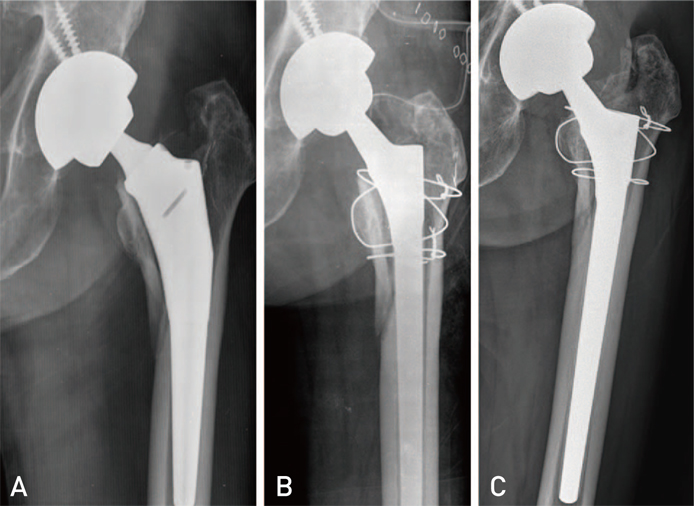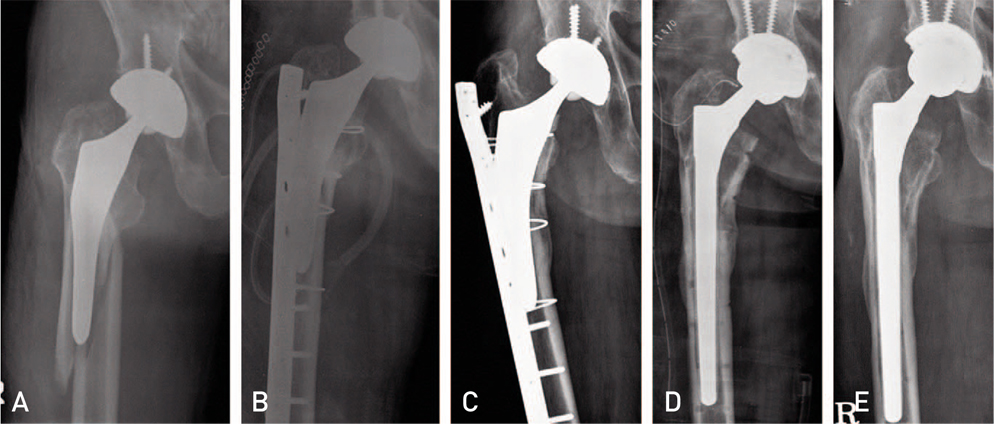Hip Pelvis.
2015 Sep;27(3):146-151. 10.5371/hp.2015.27.3.146.
Outcomes of Surgical Treatment of Periprosthetic Femoral Fractures in Cementless Hip Arthroplasty
- Affiliations
-
- 1Department of Orthopaedic Surgery, Kwangju Christian Hospital, Gwangju, Korea. paedic@chol.com
- KMID: 2069144
- DOI: http://doi.org/10.5371/hp.2015.27.3.146
Abstract
- PURPOSE
We aimed to evaluate the results of surgical treatment of periprosthetic femoral fractures in cementless total hip arthroplasty (THA).
MATERIALS AND METHODS
From June 2002 to May 2012, 40 patients who could be followed-up for more than 1 year after surgery were enrolled in this study. The mean duration of follow-up was 28.5 months (range, 15-97 months) and the average age at the time of surgery was 71.5 years (range, 38-89 years). The fracture types were determined by using the Vancouver classification. Among intraoperative fractures, there were type A in 3 hips, type B2 in 2 hips and type B3 in one. Among postoperative fractures, type AG was present in 5 hips, type AL in 2 hips, type B1 in 15 hips, type B2 in 6 hips, type B3 in 3 hips, and type C in 3 hips. Evaluation of the results was based on bony union, stability of the prosthesis, postoperative complications, and Harris hip score at the final follow-up.
RESULTS
Bony union was achieved in all but one case and the average time for bony union was 21 weeks. The mean Harris hip score was 86 at the final follow-up. Clinical results were above good in 34 of 40 hips (85.0%). Stem loosening occurred in one patient with a type B1 fracture treated with open reduction and plate fixation. Nonunion was observed in 1 patient with an AG type fracture.
CONCLUSION
Open reduction and fixation using a plate with a screw and cerclage wiring provided good results for periprosthetic fractures in patients who had a stable femoral stem without bone defects. Revision surgery with a cementless long stem should be considered in patients with an unstable stem or suspected stability in B1 type of THA using a proximal fixation type.
MeSH Terms
Figure
Cited by 1 articles
-
Prognostic Factors and Clinical Outcomes after Treatment of Periprosthetic Femoral Fractures Using a Cable-plate
Joon Soon Kang, Kyoung-Ho Moon, Bong Sung Ko, Tae Hoon Roh, Yeop Na, Yung-Hun Youn, Joo Hyun Park
Hip Pelvis. 2019;31(3):166-173. doi: 10.5371/hp.2019.31.3.166.
Reference
-
1. Lindahl H. Epidemiology of periprosthetic femur fracture around a total hip arthroplasty. Injury. 2007; 38:651–654.
Article2. Campbell P, Mcwilliams TG. Periprosthetic femoral fractures. Curr Orthop. 2002; 16:126–132.
Article3. Lewallen DG, Berry DJ. Periprosthetic fracture of the femur after total hip arthroplasty: treatment and results to date. Instr Course Lect. 1998; 47:243–249.4. Lindahl H, Malchau H, Herberts P, Garellick G. Periprosthetic femoral fractures classification and demographics of 1049 periprosthetic femoral fractures from the Swedish National Hip Arthroplasty Register. J Arthroplasty. 2005; 20:857–865.5. Berend ME, Smith A, Meding JB, Ritter MA, Lynch T, Davis K. Long-term outcome and risk factors of proximal femoral fracture in uncemented and cemented total hip arthroplasty in 2551 hips. J Arthroplasty. 2006; 21:6 Suppl 2. 53–59.
Article6. Philippe H, Nicolas D, Jerome D, et al. Long, titanium, cemented stems decreased late periprosthetic fractures and revisions in patients with severe bone loss and previous revision. Int Orthop. 2015; 39:639–644.
Article7. Cooper HJ, Rodriguez JA. Early post-operative periprosthetic femur fracture in the presence of a non-cemented tapered wedge femoral stem. HSS J. 2010; 6:150–154.
Article8. Langslet E, Frihagen F, Opland V, Madsen JE, Nordsletten L, Figved W. Cemented versus uncemented hemiarthroplasty for displaced femoral neck fractures: 5-year followup of a randomized trial. Clin Orthop Relat Res. 2014; 472:1291–1299.
Article9. Garbuz DS, Masri BA, Duncan CP. Periprosthetic fractures of the femur: principles of prevention and management. Instr Course Lect. 1998; 47:237–242.10. Haddad FS, Masri BA, Garbuz DS, Duncan CP. The prevention of periprosthetic fractures in total hip and knee arthroplasty. Orthop Clin North Am. 1999; 30:191–207.
Article11. Watts CD, Abdel MP, Lewallen DG, Berry DJ, Hanssen AD. Increased risk of periprosthetic femur fractures associated with a unique cementless stem design. Clin Orthop Relat Res. 2015; 473:2045–2053.
Article12. Capello WN, D'Antonio JA, Naughton M. Periprosthetic fractures around a cementless hydroxyapatite-coated implant: a new fracture pattern is described. Clin Orthop Relat Res. 2014; 472:604–610.
Article13. Lim SJ, Lee KJ, Min BW, Song JH, So SY, Park YS. High incidence of stem loosening in association with periprosthetic femur fractures in previously well-fixed cementless grit-blasted tapered-wedge stems. Int Orthop. 2015; 39:1689–1693.
Article14. Duncan CP, Masri BA. Fractures of the femur after hip replacement. Instr Course Lect. 1995; 44:293–304.15. Christensen CM, Seger BM, Schultz RB. Management of intraoperative femur fractures associated with revision hip arthroplasty. Clin Orthop Relat Res. 1989; (248):177–180.
Article16. Schwartz JT Jr, Mayer JG, Engh CA. Femoral fracture during non-cemented total hip arthroplasty. J Bone Joint Surg Am. 1989; 71:1135–1142.
Article17. Bethea JS 3rd, DeAndrade JR, Fleming LL, Lindenbaum SD, Welch RB. Proximal femoral fractures following total hip arthroplasty. Clin Orthop Relat Res. 1982; (170):95–106.
Article18. Kavanagh BF. Femoral fractures associated with total hip arthroplasty. Orthop Clin North Am. 1992; 23:249–257.
Article19. McElfresh EC, Coventry MB. Femoral and pelvic fractures after total hip arthroplasty. J Bone Joint Surg Am. 1974; 56:483–492.
Article20. Larsen E, Menck H, Rosenklint A. Fractures after hemialloplastic hip replacement. J Trauma. 1987; 27:72–74.
Article21. Johansson JE, McBroom R, Barrington TW, Hunter GA. Fracture of the ipsilateral femur in patients wih total hip replacement. J Bone Joint Surg Am. 1981; 63:1435–1442.
Article22. Masri BA, Meek RM, Duncan CP. Periprosthetic fractures evaluation and treatment. Clin Orthop Relat Res. 2004; (420):80–95.
Article23. Rayan F, Dodd M, Haddad FS. European validation of the Vancouver classification of periprosthetic proximal femoral fractures. J Bone Joint Surg Br. 2008; 90:1576–1579.
Article24. Beals RK, Tower SS. Periprosthetic fractures of the femur. An analysis of 93 fractures. Clin Orthop Relat Res. 1996; (327):238–246.25. Dennis MG, Simon JA, Kummer FJ, Koval KJ, DiCesare PE. Fixation of periprosthetic femoral shaft fractures occurring at the tip of the stem: a biomechanical study of 5 techniques. J Arthroplasty. 2000; 15:523–528.
Article
- Full Text Links
- Actions
-
Cited
- CITED
-
- Close
- Share
- Similar articles
-
- Periprosthetic Femoral Fractures after Hip Arthroplasty
- Fractures of the Femur associated with the Hip Arthroplasty
- Treatment of Periprosthetic Femoral Fractures after Hip Arthroplasty
- Periprosthetic Occult Femoral Fracture: An Unknown Side Effect of Press-Fit Fixation in Primary Cementless Total Hip Arthroplasty
- Could Patient Undergwent Surgical Treatment for Periprosthetic Femoral Fracture after Hip Arthroplasty Return to Their Status before Trauma?



